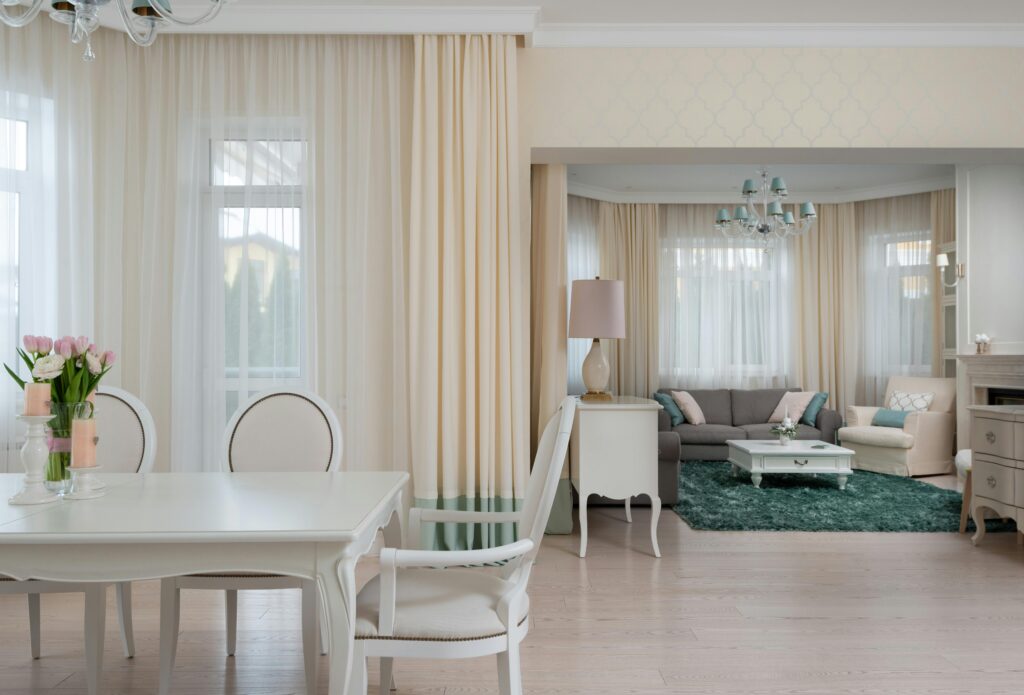If you’re a real estate agent looking to sell homes faster and for top dollar, home staging isn’t optional—it’s a game-changer. I’ve seen it firsthand. Early in my career, I had a listing that sat on the market for weeks with barely a nibble. The sellers had great taste, but their furniture was oversized, and their personal style didn’t appeal to the broadest range of buyers. After a light staging refresh—decluttering, neutralizing colors, and rearranging furniture—the home had multiple offers within days. That’s the power of staging.
And yet, I still hear agents hesitate. “Is home staging really worth it?” “Won’t buyers see past the décor?” The short answer? No, they won’t. Buyers shop with their eyes first, and an unstaged or poorly presented home is an uphill battle.
In this guide, I’ll walk you through why home staging is a must-have tool in your real estate arsenal, how to use it effectively, and when to bring in a professional stager.
Why Home Staging Matters for Real Estate Agents
I’ve worked with agents who swear by home staging and others who think it’s just another expense. But here’s the reality: staged homes sell faster and often for more money.
A well-staged home helps buyers emotionally connect with the space. Instead of focusing on an outdated paint color or an awkward layout, they envision themselves living there. I once had a buyer who walked into a vacant home and immediately dismissed it as “cold” and “lifeless.” The same home, staged with warm lighting, inviting furniture, and a cozy rug? It had three offers within a week.
Beyond aesthetics, staging also helps with marketing. Think about your listing photos—most buyers start their search online. A beautifully staged home stands out in a crowded MLS feed and draws more clicks, showings, and serious interest.
Still not convinced? Let’s talk numbers:
- According to NAR, 81% of buyers find it easier to visualize a staged home as their future home.
- Staged homes sell 3x faster than non-staged homes, on average.
- According to the Real Estate Staging Association (RESA), staging can yield an average ROI of approximately 586%.
This means that for every dollar spent on staging, sellers can potentially receive an average of $5.86 in return. For example, investing $3,000 in staging could result in a $17,580 increase in the sale price. This substantial ROI underscores the financial benefits of incorporating staging into your sales strategy.
It’s not just about making a home look pretty—it’s a strategic tool that makes your job easier and more profitable.
The Biggest Home Staging Myths (And Why They’re Wrong)
Even with all the benefits, I still hear agents and sellers push back on home staging. Let’s break down the most common objections and why they don’t hold up.
Myth #1: “Buyers Can See Past the Clutter”
I’ve lost count of how many times I’ve heard this one. The truth? Most buyers can’t. I once showed a gorgeous home with stunning hardwood floors and a spacious layout. But the sellers had towering bookshelves overflowing with paperwork, mismatched furniture, and a giant fish tank in the middle of the living room. The buyers couldn’t get past the mess. They didn’t comment on the natural light or the open floor plan—they just saw “too much stuff.”
Myth #2: “Staging Is Too Expensive”
I get it—no seller wants to spend money they don’t have to. But staging doesn’t always mean renting furniture or hiring a professional for thousands of dollars. I’ve helped sellers stage homes on a budget with simple fixes: fresh paint, updated light fixtures, and rearranging existing furniture. Even small investments can make a huge difference.

Myth #3: “Empty Homes Look Bigger”
A vacant home might seem like a blank canvas, but to buyers, it often feels cold and uninviting. Without furniture, it’s harder to gauge the size of a room or imagine how it functions. I once listed an empty home with a massive living room, but buyers kept asking, “Where would the TV go?” and “Would a couch even fit here?” We staged it with a sectional and a cozy rug, and suddenly, buyers could see themselves living there.
How to Stage a Home Without Breaking the Bank
Staging doesn’t have to mean spending thousands on rented furniture or hiring a designer. I’ve helped sellers transform their homes with simple, cost-effective strategies that make a big impact. Here’s how you can do the same.
1. Declutter and Depersonalize
This is the easiest and cheapest way to stage a home. I always tell sellers, “If you don’t need it for the next three months, pack it up now.” The goal is to make the home feel spacious and neutral so buyers can imagine themselves living there.
Quick wins:
- Remove family photos, religious items, and personal collections.
- Clear off countertops in kitchens and bathrooms.
- Edit down furniture—less is more.
I once had a seller with a home office packed with filing cabinets and old paperwork. After clearing it out and adding a simple desk and chair, it felt twice the size and showed beautifully.
2. Focus on Key Rooms
Not every room needs to be fully staged. If budget is tight, focus on the spaces that matter most to buyers:
- Living Room: Arrange furniture to highlight natural light and create conversation areas.
- Primary Bedroom: A neutral color scheme, crisp bedding, and minimal decor make it feel like a retreat.
- Kitchen: A bowl of fresh fruit and simple, coordinated accessories work wonders.
I once worked with a seller who didn’t want to stage an extra bedroom. We simply added an air mattress, dressed it up with bedding, and placed a small nightstand next to it. Buyers assumed it was a fully furnished guest room!

3. Improve Lighting and Curb Appeal
First impressions matter. Before buyers even step inside, they’re judging the home. Simple fixes can make a world of difference.
Lighting Fixes:
- Replace outdated light fixtures with modern, affordable options.
- Use warm, consistent lighting throughout the home.
- Open blinds and remove heavy drapes to let in natural light.
Curb Appeal Boosters:
- A fresh coat of paint on the front door.
- Potted plants or flowers by the entryway.
- A power wash for the driveway and walkway.
I once had a listing that wasn’t getting much traffic. The house itself was beautiful, but the overgrown bushes and faded front door made it look neglected. A weekend’s worth of yard work and a new coat of paint later, and showings picked up immediately.
4. Use Mirrors to Create Space
Mirrors are one of my go-to tricks for making rooms feel bigger and brighter. A well-placed mirror reflects light and gives the illusion of more space. I once staged a narrow hallway by hanging a large mirror at the end—it instantly felt twice as wide.
Best places to add mirrors:
- Opposite windows to maximize natural light
- Over fireplaces or in entryways for a polished look
- In small dining rooms to create a sense of openness
5. Refresh Walls with Neutral Paint
If there’s one home improvement that delivers the best bang for your buck, it’s paint. Bold or outdated colors can turn buyers off, while neutral tones make a home feel clean, fresh, and move-in ready.
Best staging-friendly paint colors:
Color | Why It Works |
Soft Gray | Modern, works with any decor |
Warm Beige | Cozy and inviting |
Light Greige | Perfect balance of gray and beige |
Crisp White | Makes spaces feel open & bright |
I had a seller with a bright red dining room—stylish but highly personal. We painted it a soft gray, and suddenly, the space felt elegant and sophisticated.
6. Update Hardware & Fixtures
Replacing outdated cabinet handles, doorknobs, and light fixtures is one of the easiest ways to modernize a home without a full renovation. Swapping brass fixtures for matte black or brushed nickel can instantly elevate a space.
Small upgrades that make a big difference:
Upgrade | Estimated Cost | Impact |
Kitchen cabinet handles | $30-$100 | Instantly makes cabinets look new |
Light switch plates | $10-$20 | Small detail that modernizes a room |
Bathroom faucets | $50-$150 | Adds a fresh, updated feel |
Pendant lights | $100-$300 | Gives kitchens a designer touch |
I once had a seller who refused to replace their old brass doorknobs, thinking no one would notice. But guess what? Buyers did. A simple switch to sleek black handles made the entire home feel more contemporary.

7. Add Inviting Final Touches
Once the big fixes are done, it’s time to add the small details that make a home feel warm and welcoming.
Simple finishing touches:
- A bowl of fresh fruit or a vase of flowers on the kitchen counter
- Fluffy white towels in the bathrooms (hotel-style)
- Soft throws and pillows on the sofa for a cozy vibe
- Lightly scented candles or diffusers with a clean, fresh scent (avoid anything too strong)
One time, I staged a home with a cozy breakfast nook. I added a simple place setting—white plates, cloth napkins, and a small vase of flowers. It made the space feel instantly more inviting, and buyers kept commenting on how “homey” it felt.
Bonus: How to Convince Sellers to Stage Their Home
One of the biggest challenges as an agent isn’t staging itself—it’s getting sellers on board. Many homeowners don’t see the need, worry about the cost, or believe their home is “fine as it is.” If you’ve ever had a seller push back on staging, you’re not alone. Here’s how to handle common objections and make a compelling case.
Show the Numbers
Most sellers respond to hard data. If they’re hesitant, share statistics that prove staging isn’t just about looks—it’s about results.
- Staged homes sell 3x faster than non-staged homes.
- 83% of buyer’s agents say staging helps buyers visualize the home as their future home (NAR).
- A small investment in staging often leads to a higher selling price—sometimes by 5-10% more.
I once had a seller refuse staging because they didn’t want to “waste money.” I showed them local comps—similar homes that sold faster and for more because they were staged. That convinced them to invest in small changes, and their home sold in under a week.
Use Before-and-After Photos
Nothing drives the point home like visuals. Keep a collection of before-and-after staging photos from past listings (or borrow examples from staging professionals) to illustrate the difference.
I had a seller with a dark, cluttered living room who thought buyers would “see past it.” I pulled up a staged version of a similar room, and suddenly, they understood the impact. Once we made a few changes—lighter furniture, a fresh rug, and better lighting—their home felt completely different, and buyers noticed.
Position Staging as a Marketing Strategy
Explain to sellers that staging isn’t about redecorating—it’s about maximizing their home’s appeal to buyers. Compare it to any other business:
- Would a car dealership sell a dirty, cluttered car? No, they detail it before putting it on the lot.
- Would a clothing store throw shirts on the floor instead of displaying them neatly? Of course not.
Homes are no different. A well-presented home attracts more buyers, generates more interest, and ultimately sells for more.
Offer Staging Options That Fit Their Budget
Some sellers think staging means hiring a designer for thousands of dollars. Reassure them that staging can be flexible and cost-effective.
Staging Approach | Best For | Estimated Cost |
DIY Staging (Declutter, rearrange furniture, add décor) | Budget-conscious sellers, occupied homes | Free – $200 |
Agent-assisted staging (Light staging with existing items) | Homes that need small tweaks | $200 – $500 |
Professional consultation (Advice from a staging expert) | Homes that need guidance but not full staging | $250 – $600 |
Full-service staging (Renting furniture & accessories) | Vacant homes, luxury listings | $2,000+ |
I once had a seller who refused staging until I offered a simple, low-cost approach. We did a DIY declutter, moved some furniture, and added a few modern touches. The result? A full-price offer within days.
Final Thoughts: Staging is a Must-Have Sales Tool
As an agent, your job is to help sellers get the best possible price in the shortest amount of time. Home staging isn’t just about making a property look nice—it’s a strategic tool that influences buyer perception, increases interest, and ultimately leads to better offers.
You don’t have to be a professional designer or spend thousands of dollars to make staging work for your listings. Even simple changes—decluttering, neutralizing colors, updating lighting, and adding thoughtful details—can have a massive impact. And when the situation calls for it, bringing in a professional stager can take a listing from “nice” to “irresistible.”
If you’re not already incorporating staging into your marketing strategy, now is the time. The results speak for themselves: faster sales, higher prices, and happier clients. And in this business, that’s what it’s all about.









